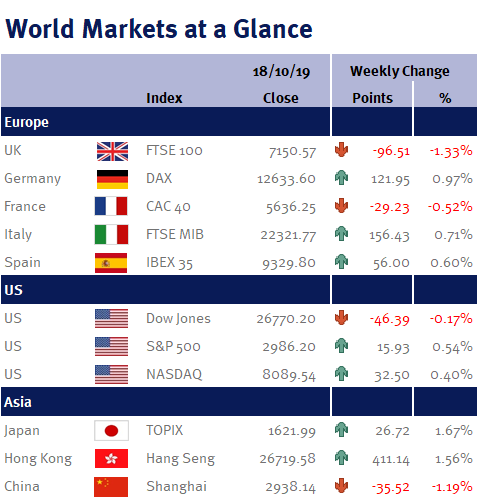Minutes of the Fed’s September monetary policy meeting were released on Wednesday (9 October 2019). They showed that although policymakers believed that downside risks to the outlook for economic activity had increased (particularly those stemming from the trade spat with China), five policymakers thought it was a mistake to cut US interest rates and a number of policymakers wanted the Fed to signal the limits of their policy easing (i.e. they want to set the bar higher for additional interest rate cuts).
However, they also discussed their objective to get inflation back up to their 2% target – and yesterday’s (Thursday 10 October 2019) unchanged US CPI inflation (1.7%) should hopefully help encourage Fed policymakers to ease monetary policy further. As we have previously stated, we believe that the US Fed will cut US interest rates again when policymakers meet at the end of this month.
In the UK, the pound strengthened on news that there was a “pathway” to a potential Brexit deal after Boris Johnson and his Irish counterpart, Leo Varadkar, met yesterday (Thursday 10 October 2019).
However, it is important not to get carried away as it’s hard to see what Boris Johnson actually offered that would be acceptable in Westminster, Dublin, Belfast and Brussels. Additionally, given the joint statement went on to say that they have “agreed to reflect further on their discussions and that officials would continue to engage intensively on them”, suggests that they didn’t make that much progress!
Although a last minute Brexit deal can’t be fully dismissed, at present, the most likely outcome appears to be a Brexit delay followed by a general election, which will, in effect, be a second referendum on Brexit. And unfortunately, no matter how you slice it, Brexit uncertainty will continue as an extension does nothing except prolong the economic uncertainty, while an election may not end the current political gridlock.
Looking ahead to this coming week, we have the Queen’s Speech and an EU Summit. Additionally, in the UK we have employment data (unemployment rate and weekly earnings), CPI and retail sales. Elsewhere we have US retail sales; the Fed’s Beige Book; Eurozone CPI; and Chinese GDP.
Investment Management Team


